Introduction
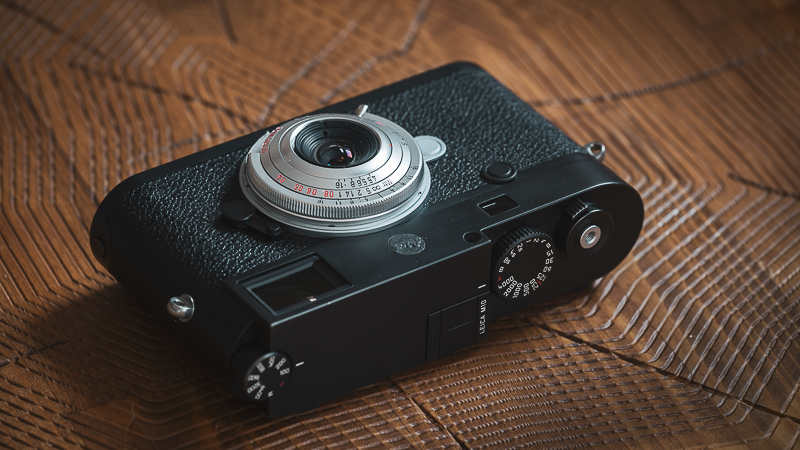
The MS-Optics 17mm 4.5 Perar is Miyazaki’s widest M-mount lens so far and thanks to a reader I got the chance to have a closer look at it. I like very small lenses, I like ultra wide lenses, so nothing can go wrong here, right?
Lens is being tested on 42mp Sony A7rII and 24mp Leica M10
Sample Images
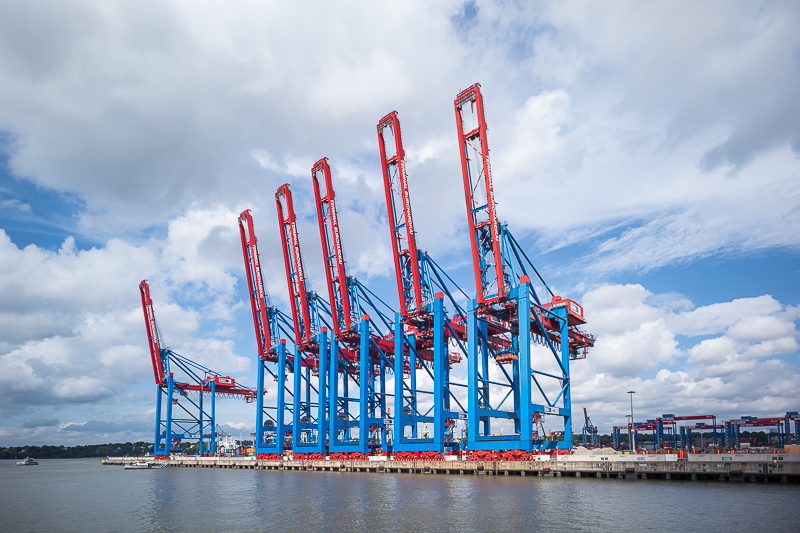
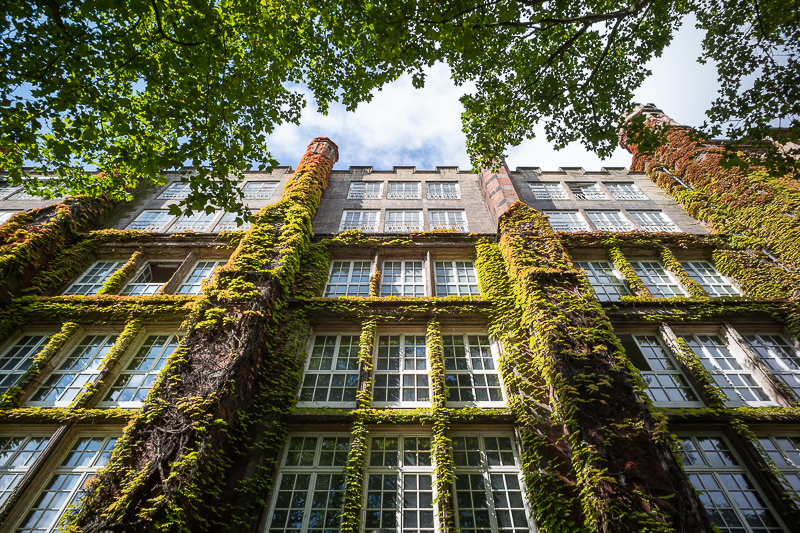
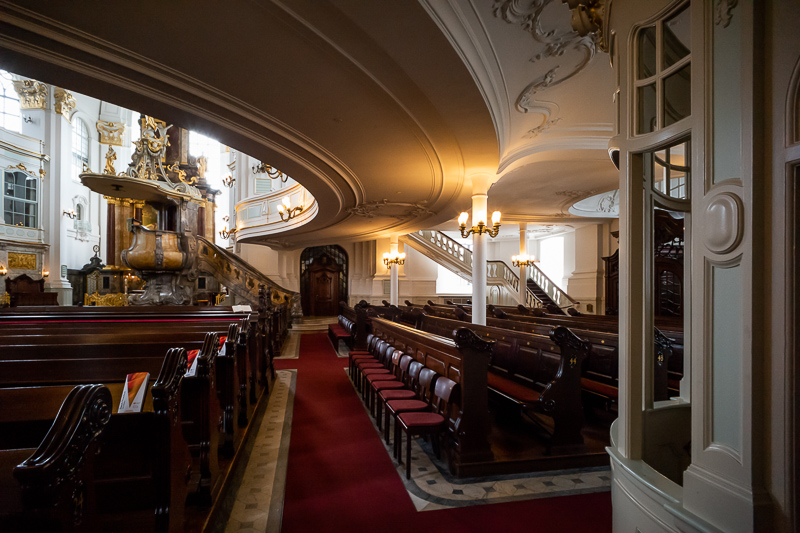
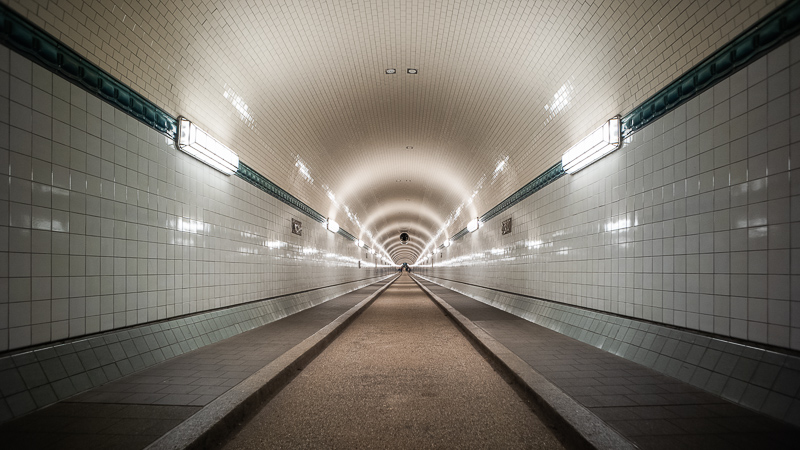
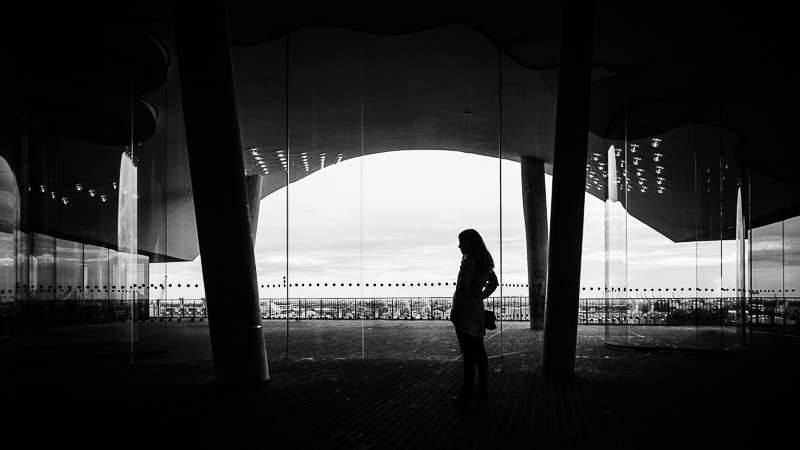
You can find most of the sample images in full resolution here.
Contents
Disclosure
The MS-Optics 17mm 4.5 Perar was kindly provided by our reader Christian for a review. He is also active under the name gladstone at digicamclub.de.
Specifications / Version History
You can find information on all the MS-Optics M-mount lenses in my Overview: MS-Optics M-mount lenses. The MS-Optics Perar 17mm 4.5 is the widest MS-Optics lens so far and has the following specifications:
-
- Diameter: 50mm
- Field of view: 100° (diagonally)
- Length: 10.2mm
- Weight: 47g (measured, without hood)
- Filter Diameter: 34mm*
- Number of Aperture Blades: 10
- Elements/Groups: 4/4
- Close Focusing Distance: 0.3 m (measured)
- Maximum Magnification: 1:16 (measured)
- Mount: Leica-M
*you are supposed to salvage the glass from a 34mm filter and glue that glass element to the lens hood
These days you can mainly find this lens used on ebay.com (affiliate link), but a few stores still have old stock. The price for a new one in Japan is around $450/450€
Handling / Build Quality
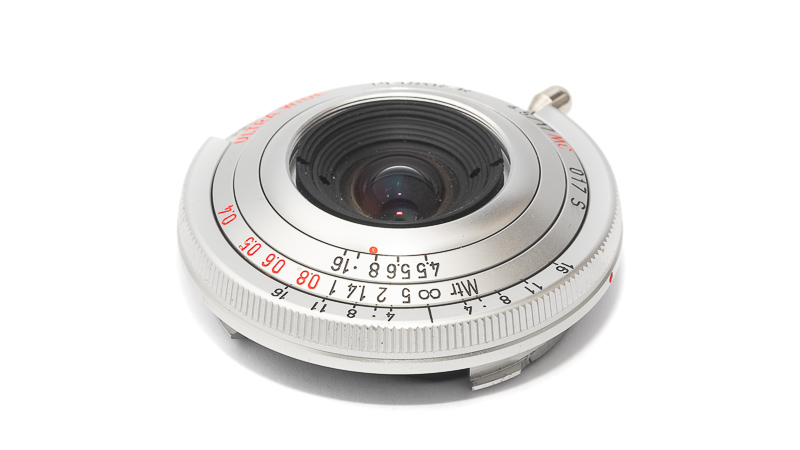
On focusing the whole lens rotates and while I am usually not a big fan of focus tabs here the small lever comes in very handy. The lens rotates ~90° from the minimum focus distance (0.3m) to infinity. The lens is rangefinder coupled between 0.8 m and infinity.
Setting the desired aperture value is a fiddly endeavour, as only the small inner ring serves as aperture ring and there are not even grooves like on the Aporia 24mm 2.0 to be able to grab it.
Here the lens hood attaches directly to the aperture ring though, so you can actually grab and use the hood to change the aperture value.
The lens is tiny, see this comparison to a Leica M body cap:

As is the case with every MS-Optics lens I have used so far (except for the 135mm 2.4 Aporis): on the Leica M10 the 6-bit-code-reader is not fully covered and therefore under bright light the camera will often think you changed the lens and throw you ouf of live view should you be using that. I added a small piece of duct tape which solves the issue, it looks particularly nice on a silver lens:
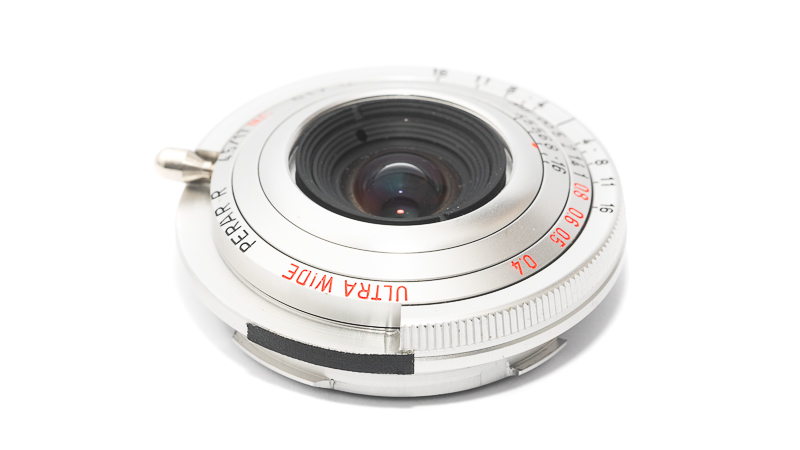
The filter situation is also once more very interesting, as the small leaflet says: 34mm filter, only glass. What does it mean? It means you are supposed to salvage a 34mm filter by removing the glass element and then glueing this glass element to the front of the small lens hood. Enjoy!
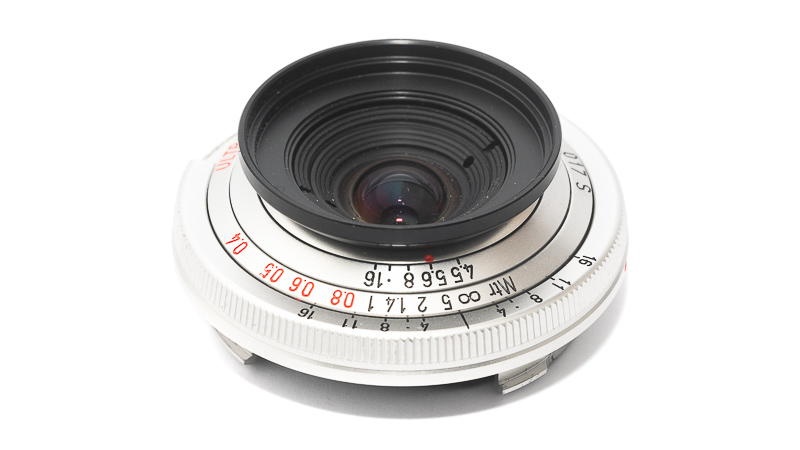
My current M-mount lens of choice in this focal length range is the Voigtländer VM 15mm 4.5 II, where I had the hood cut off to make it more compact and allow for easier use of filters. Still, compared to the Perar it looks like a huge lens:
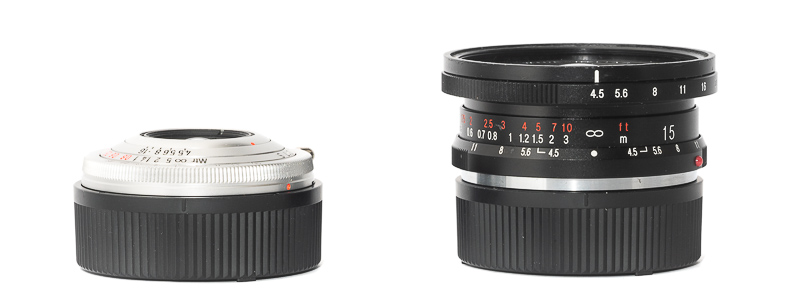
Vignetting
light falloff
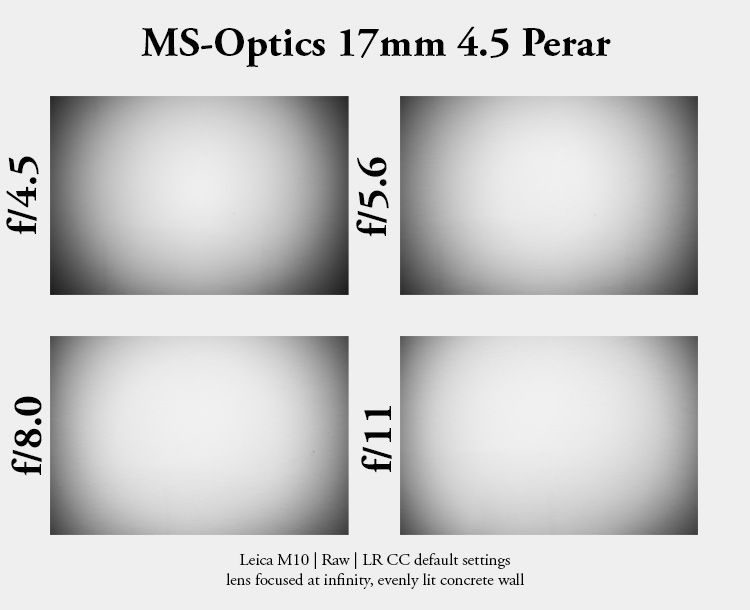
| f/4.5 | 4.3 EV |
| f/5.6 | 4.0 EV |
| f/8.0 | 3.7 EV |
| f/11 | 3.5 EV |
| f/16 | 3.2 EV |
Considering the dimensions we were expecting high vignetting, right? We did not get disappointed, as these values are almost record breaking. Stopped down they are quite similar to the Voigtlander VM 15mm 4.5 II though.
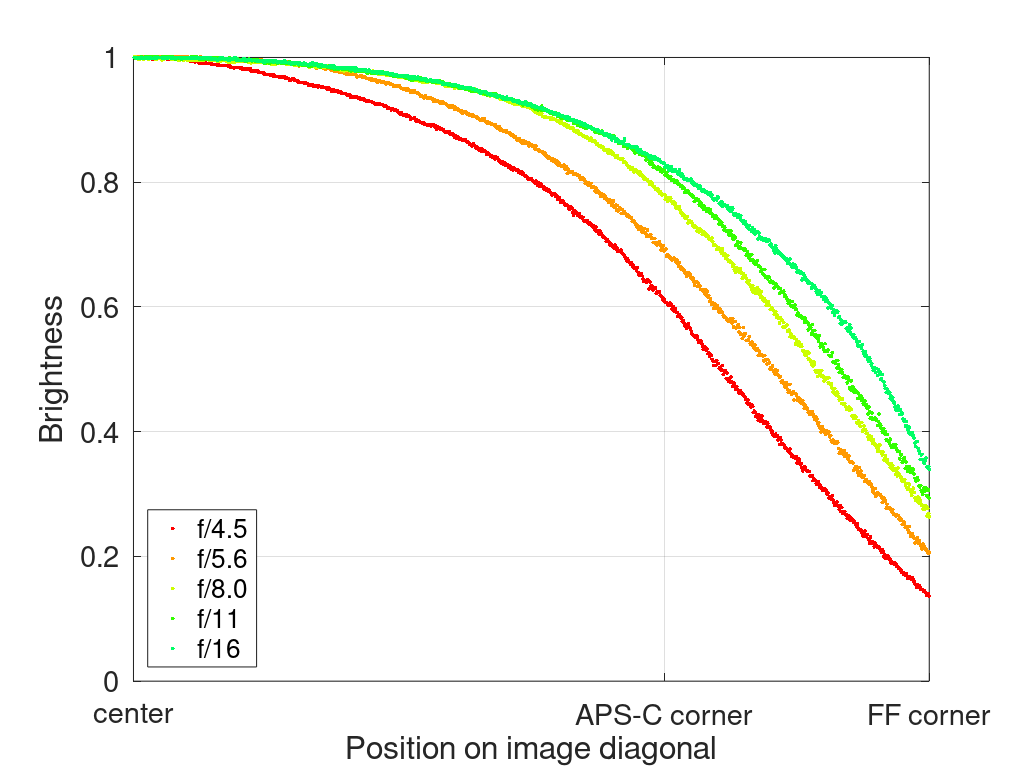
It is recommended to have a look at this article first to get an idea how this brightness graph works.
color cast
Sensor design makes a big difference here. On the A7rII we have a bit of a green color cast in all the 4 corners, which is what we have often seen in the past with other compact ultra wide lenses as well.
On the M10 the situation is very different: the left side of the frame shows a bit of green color cast while the right side of the frame shows a strong magenta color cast.
Also have a look at the Distortion section where I show an image with/without color cast corrections.
This is what it looks like in an unedited picture:

You can check out my article How to: Correcting Color Cast in Lightroom where I explain different methods to fix this.
Sharpness
MTF-Graphs
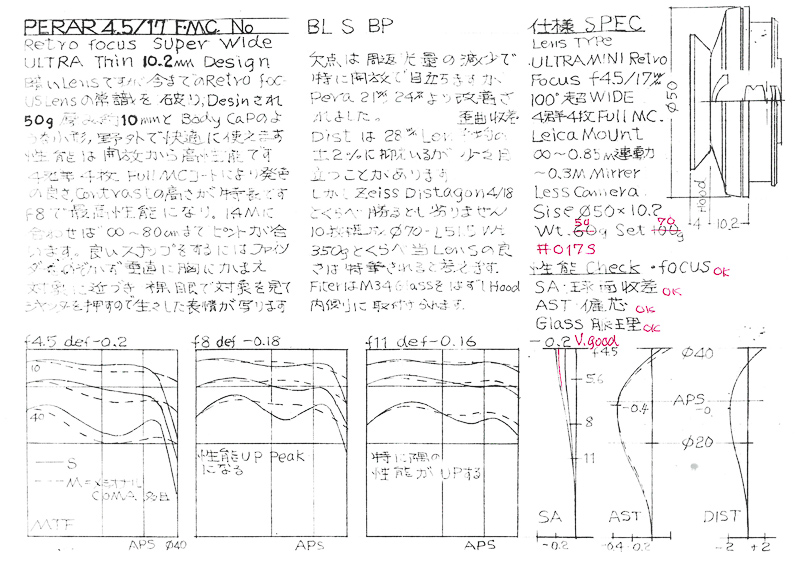
The MS-Optics lenses always come with hand-drawn MTF-graphs which do give a hint what to expect.
The graphs show a good performance at the maximum aperture from the center to the APS-C corners, but a steep drop in performance past that.
This significantly improves on stopping to f/8.0, but f/11 seems to be needed for best corner performance.
Let’s find out how these MTF graphs translate into reality.
infinity (42mp Sony A7rII)
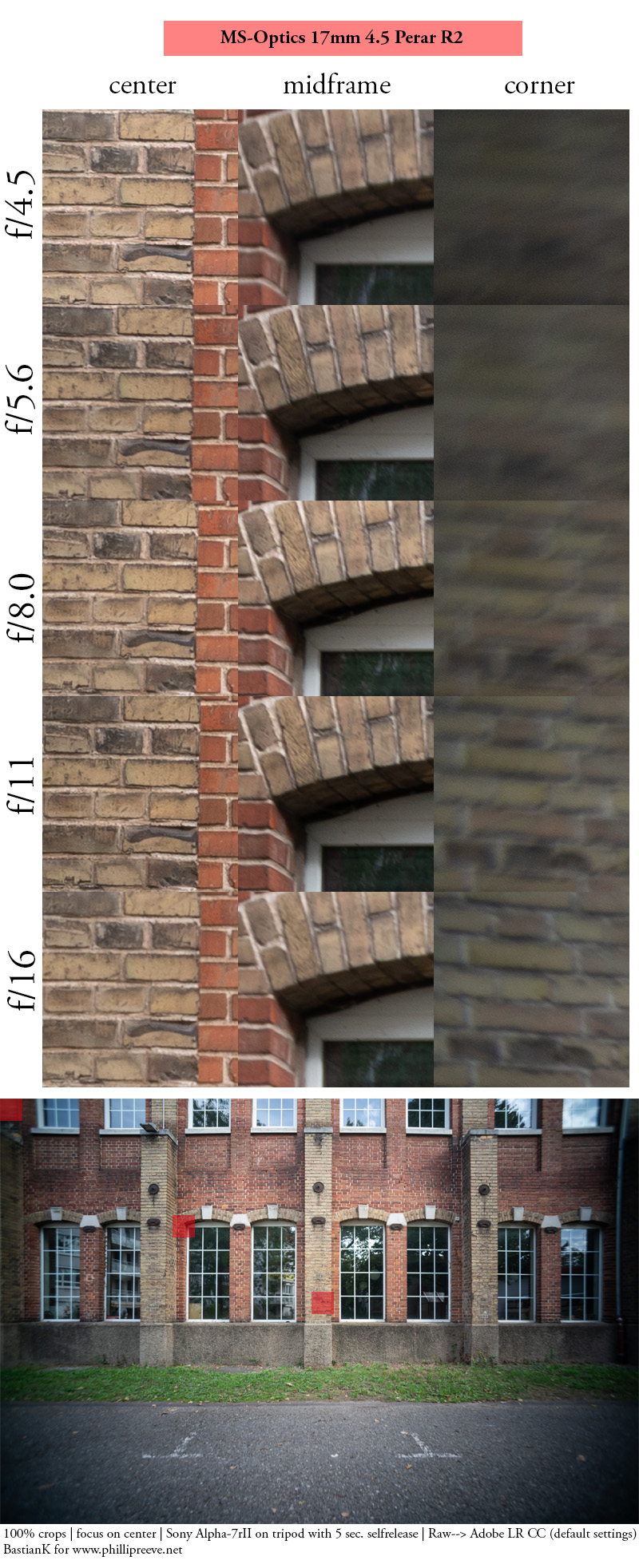
The center looks good from f/4.5, the midframe lacks about one stop behind, but the corners are just a mess.
By f/8.0 most of the frame does look good, but the corners actually benefit from stopping down to f/16. Because of diffraction I usually don’t stop down further than f/11, but here I might actually consider using f/16 so the corners look less distractingly bad.
Let us see in the next section how the lens performs on a camera with a thinner filter stack which it ought to have been designed for.
infinity (24mp Leica M10)
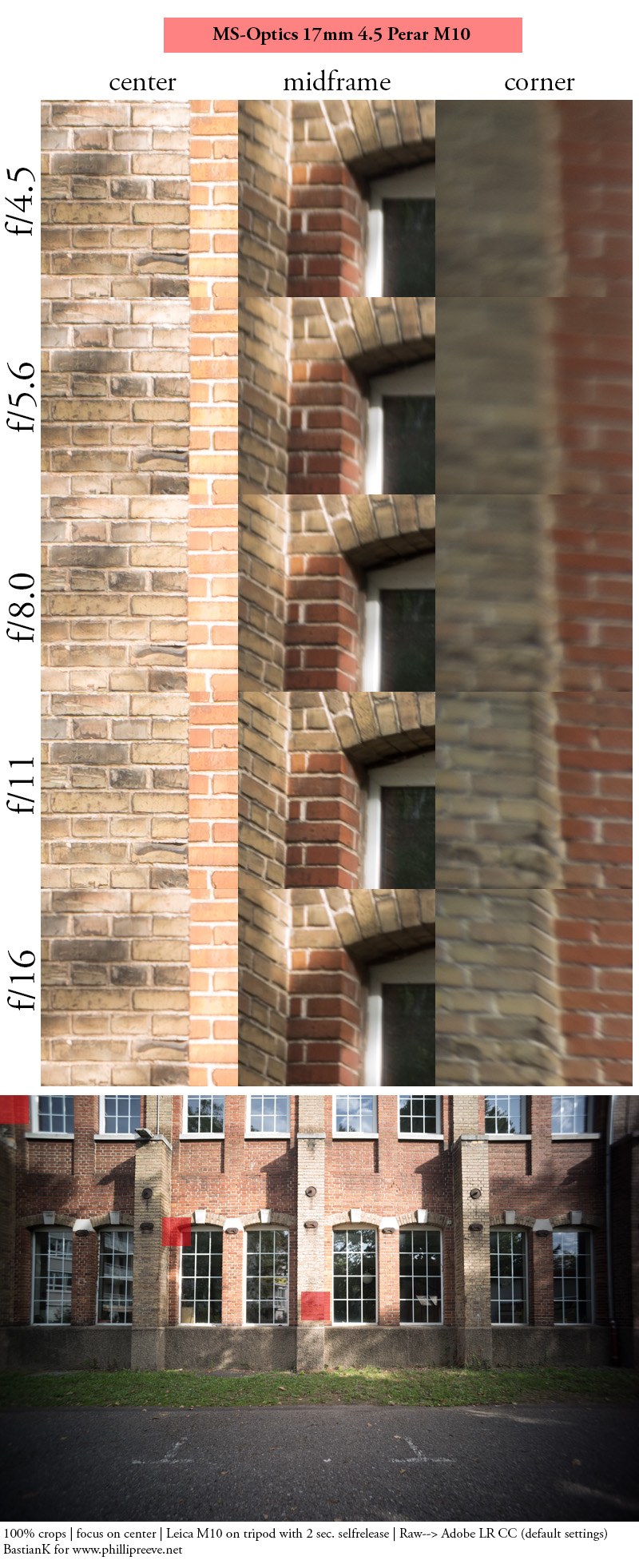
Interestingly the performance on the Leica M10 with its thinner filter stack is very similar. The corners do show a bit more details at shared apertures, but again I would stick to f/11 to f/16 if there are fine details close to the borders and corners of the frame – if possible.
close (0.3 m, 1:16)
100% crops from center, Sony A7rII
The official minimum focus distance is 0.4 m, but I actually measured 0.3 m. Not bad for a 17mm M-mount lens. Performance in the center is great from f/4.5, but as is the case for most ultra wide angle lenses the field is not flat at all at these distances. Still, with the subject close to the center of the frame you can create some dramatic perspectives.
Flare resistance
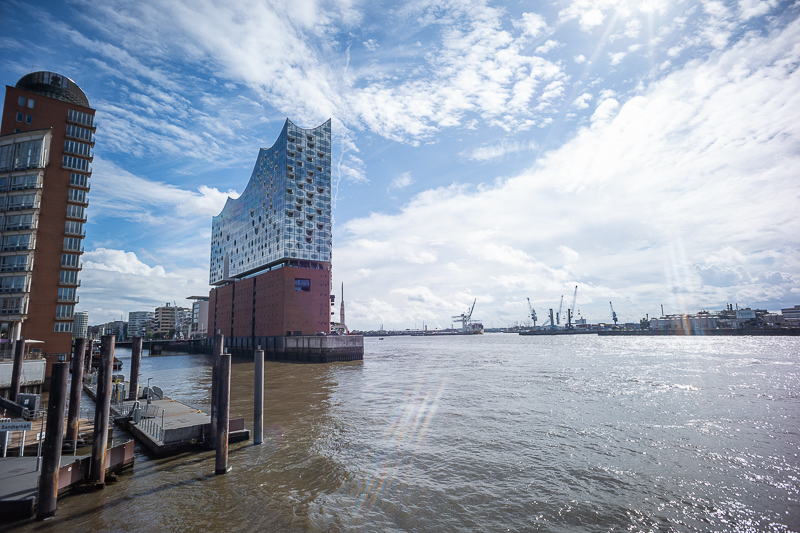
As always evaluating flare is a complex matter since you can get any lens to look bad if you push it hard enough and a slight change of scenario can affect results a lot.
This MS-Optics 17mm 4.5 is actually doing a good job though. Ghosts are hardly an issue, the only things to watch out for are internal reflections when shooting at f/4.5 (which I don’t really advise to do anyway) and sunstars turning into long streaks.
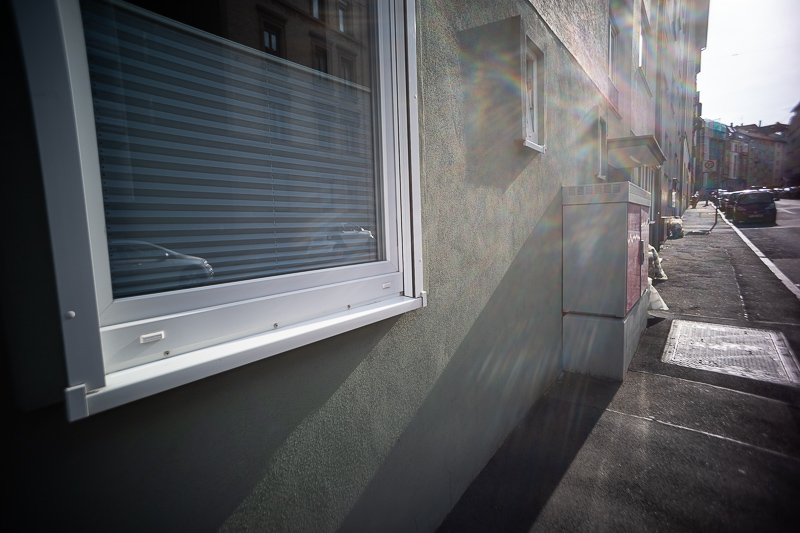
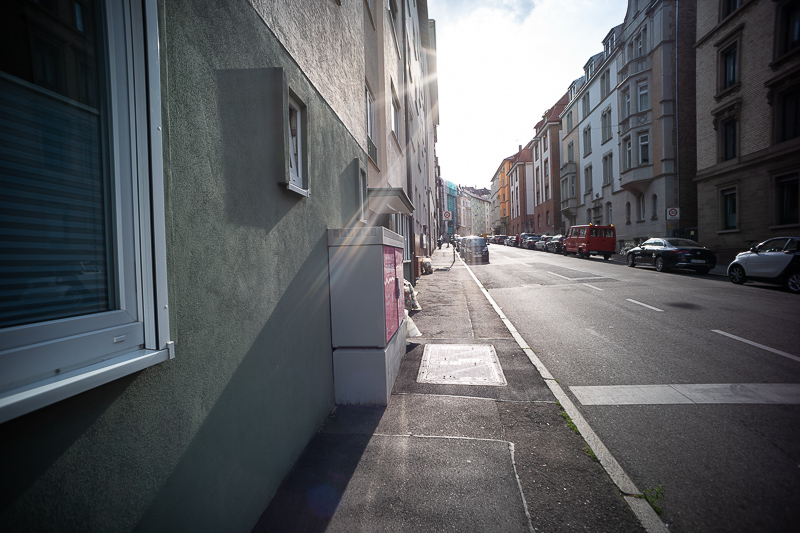
These are also somewhat engineered scenarios, in the field the flare resistance of this lens never got in the way.
Coma
100% crops from extreme corner, Leica M10
At wider aperture it seems not coma is the main issue, but field curvature, as the corners are not in the same focal plane as the center of the frame. What I said in the sharpness section is again obvious here: if there are any details close to the corners or borders and the light situation allows for it: better stop down to f/11 or even f/16.
Distortion
Leica M10 | MS-Optics 17mm 4.5 Perar | f/8.0
Now this was a negative surprise. The distortion is very wavy, I am even tempted to say Saymang 14mm 2.8 level wavy, but here the most distorted areas are the corners, not the center. Luckily this 17mm 4.5 is one of the few MS-Optics lenses where there is actually a Lightroom profile available. I still didn’t find it to correct the distortion completely though and added -4, this leads to very likable results, even suitable for architecture shooting. A bit viewing angle is lost in the correction process though.
After seeing this I created a preset for this lens in combination with the Leica M10 to get rid of the ugly asymmetrical color cast and to lower the vignetting a bit.
I used this preset for most of the sample pictures in this review.
Sunstars
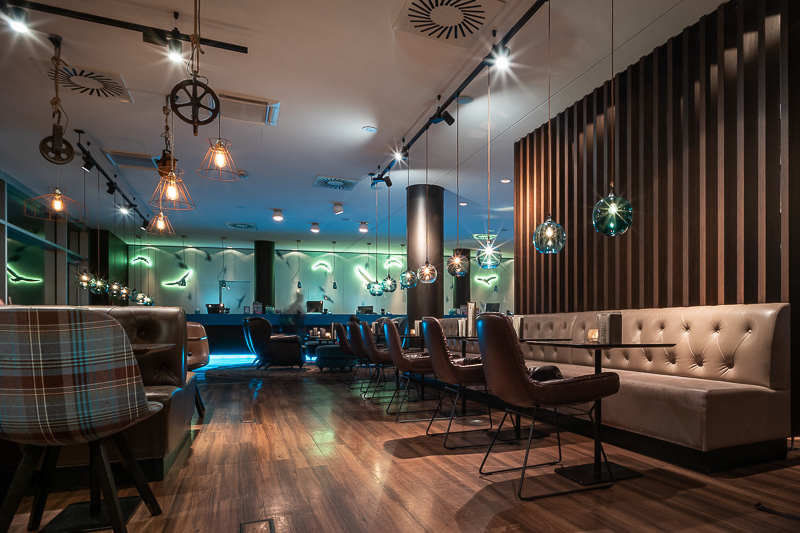
The MS-Optics 17mm 4.5 Perar is using 10 tiny aperture blades. When shooting into the sun there are some issues with reflections, but at night I found it to produce actually nice sunstars.
If you want to learn more about this topic have a look at this article.
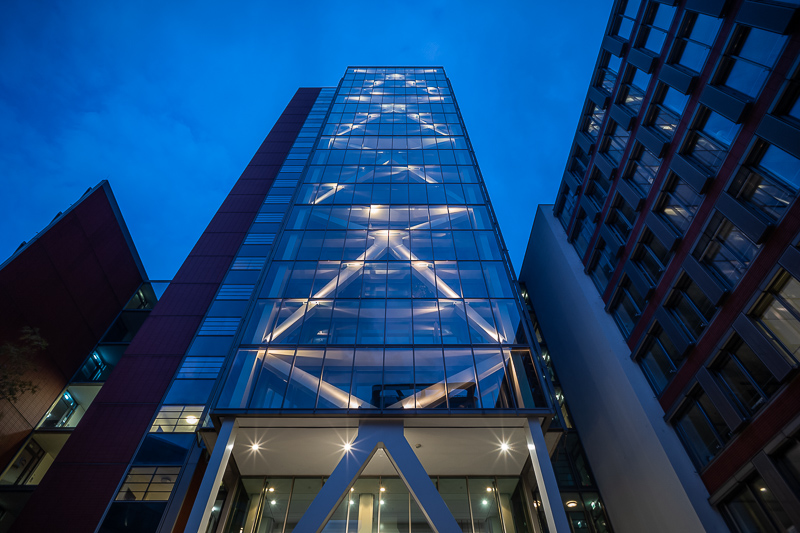
Chromatic Aberrations
lateral
Ultra wide lenses with a retrofocus design often show strong lateral CA and the MS-Optics 17mm 4.5 Perar is no exception. Luckily the lateral CA are still easily corrected in a raw developer like Lightroom by one click.
Leica M10 | MS-Optics 17mm 4.5 Perar | f/8.0 | 100% crops from border
longitudinal
Bokeh fringing is not really an issue when it comes to slow ultra wide angle lenses, but what about purple fringing? Luckily there is none to be found, even at the maximum aperture.
Leica M10 | MS-Optics 17mm 4.5 Perar | f/4.5
Alternatives
As usual when dealing with MS-Optics lenses the list of alternatives is a short one. There is actually another MS-Optics lens which comes to mind, the Hipolion 19mm f/8.0, which is even smaller, but I haven’t used it yet and being a 2 element design I don’t expect better performance from it (their MTF graphs are backing up my theory).
The closest less exotic alternative is the Voigtländer VM 15mm 4.5 Super-Wide.Heliar MK I or MK II. A very capable and compact lens with significantly better performance at wider apertures and less quirky handling. It is 3 times the weight though and noticeably bigger. Unfortunately it also has some issues with color cast on the M10 and earlier digital Leica M cameras.
Apart from that there are the already discontinued Zeiss ZM 18mm 4.0 Distagon and the Leica 18mm 3.8 Super-Elmar, both lenses I haven’t personally used and I don’t consider actual alternatives due to their size.
Conclusion
good
|
average
|
not good
|
It was surely an interesting and enjoyable experience to have a closer look at the MS-Optics 17mm 4.5 Perar. As is always the case with the MS-Optics lenses it is amazingly compact and lightweight and as is also usually the case there are some notable compromises one should be aware of.
Here the most obvious one is the high, wavy distortion, which I pretty much always felt the need to correct. Because of this type of distortion I also don’t think this lens is a particularly great choice on film.
Another one are the resolution figures. If there is something with fine structures located close to the borders and/or corners of the frame the Perar 17mm 4.5 shouldn’t be used below f/11.
At the end of the day I personally prefer the Voigtländer VM 15mm 4.5 MK II. While noticeably bigger and heavier it is still a very small lens (especially when you have the hood cut off like I did) and thanks to using aspherical elements it offers significantly better across frame sharpness and also very low distortion. Both lenses share the color cast issues on most digital Leica bodies and the generally high vignetting figures though.
As you can see from the sample pictures I was using this 17mm 4.5 Perar as (the only) ultra wide angle lens during a trip to Hamburg and I don’t feel like I was missing out on something.
These days you can mainly find this lens used on ebay.com (affiliate link), but a few stores still have old stock. The price for a new one in Japan is around $450/450€
Further Sample Images
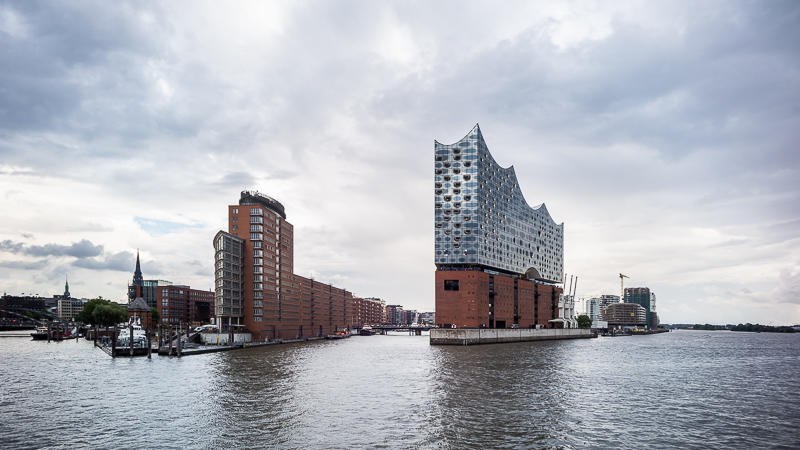
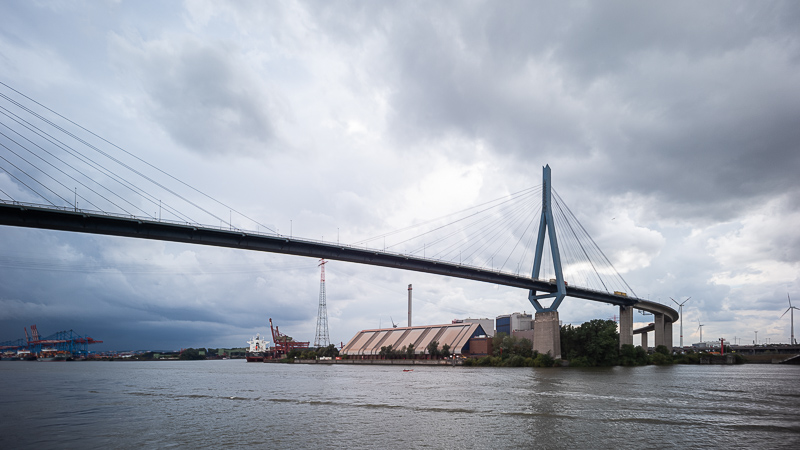
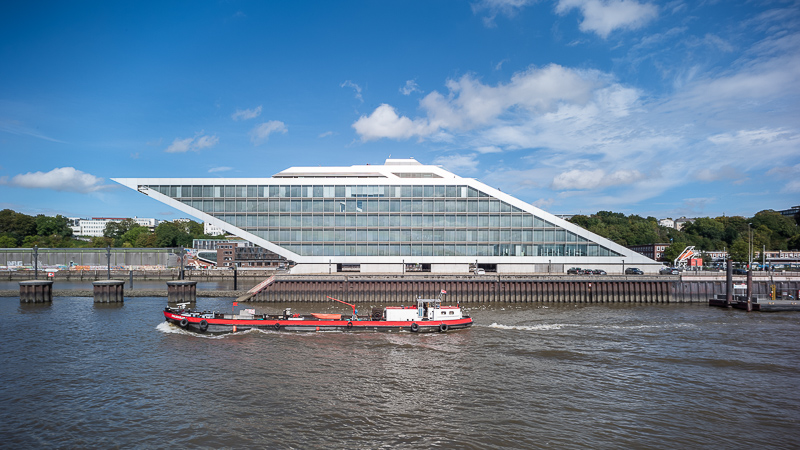
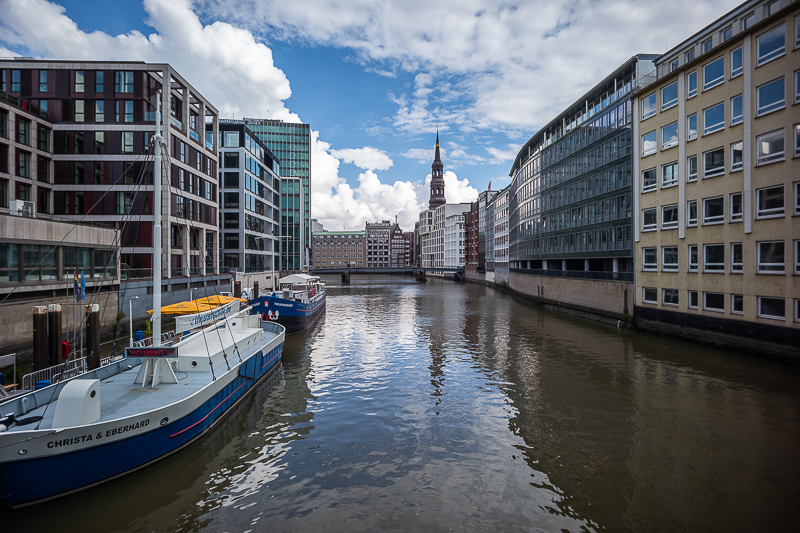
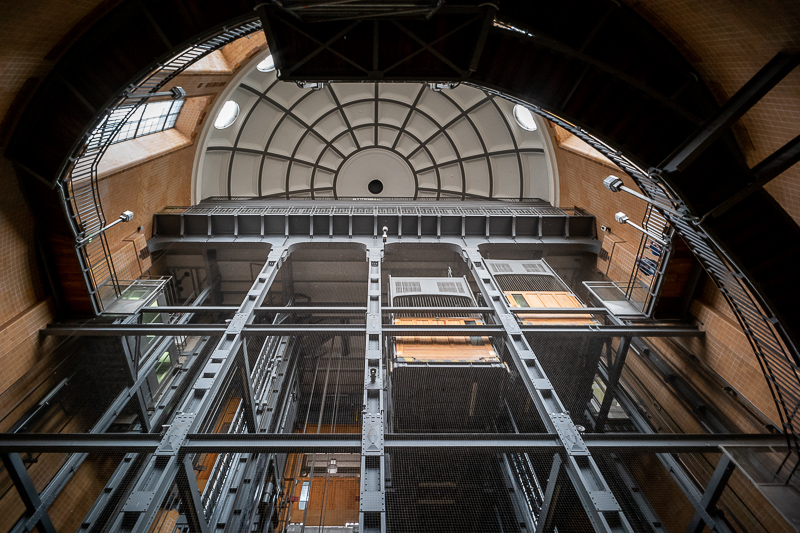
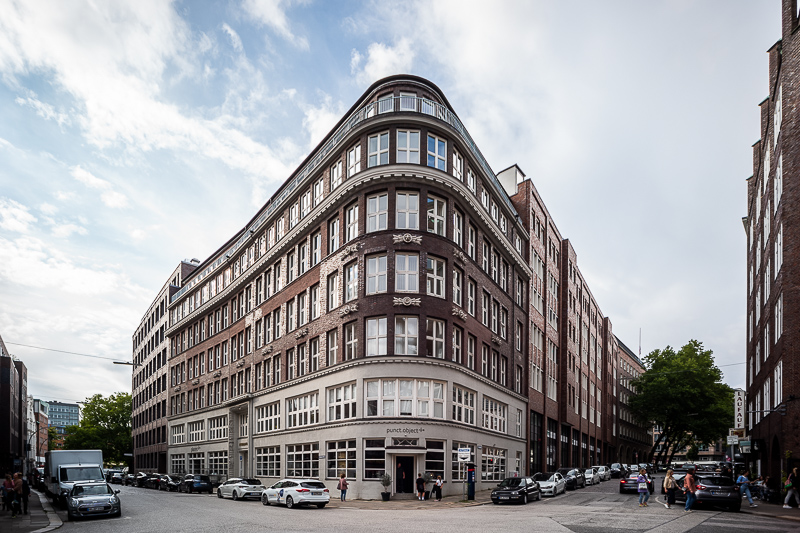
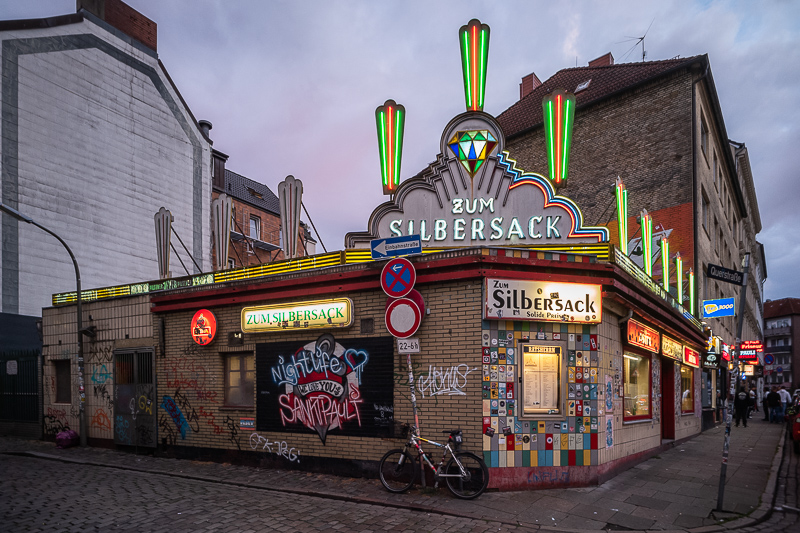
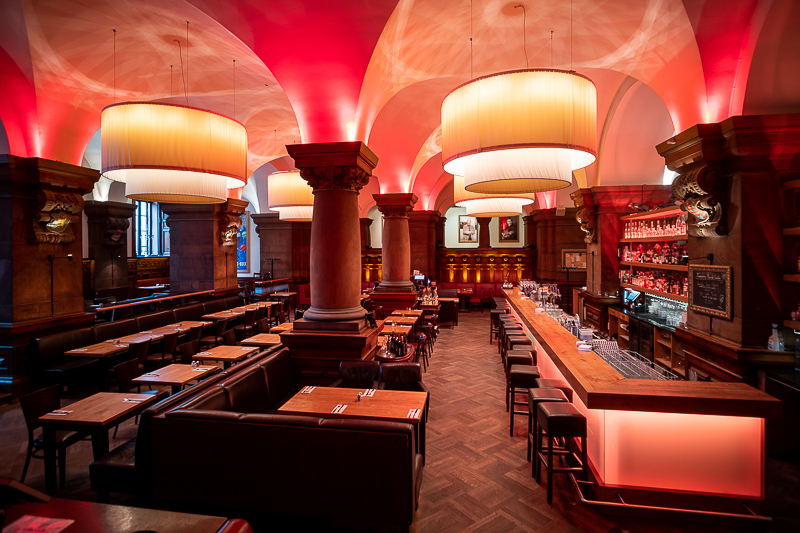
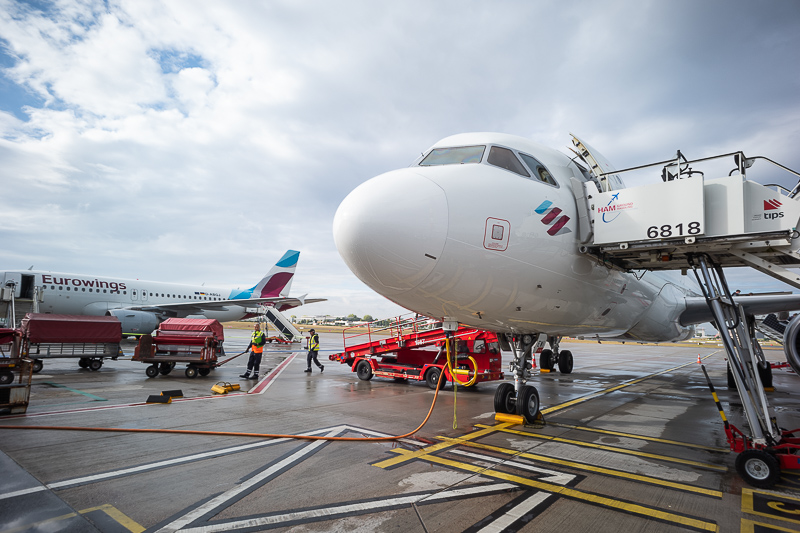
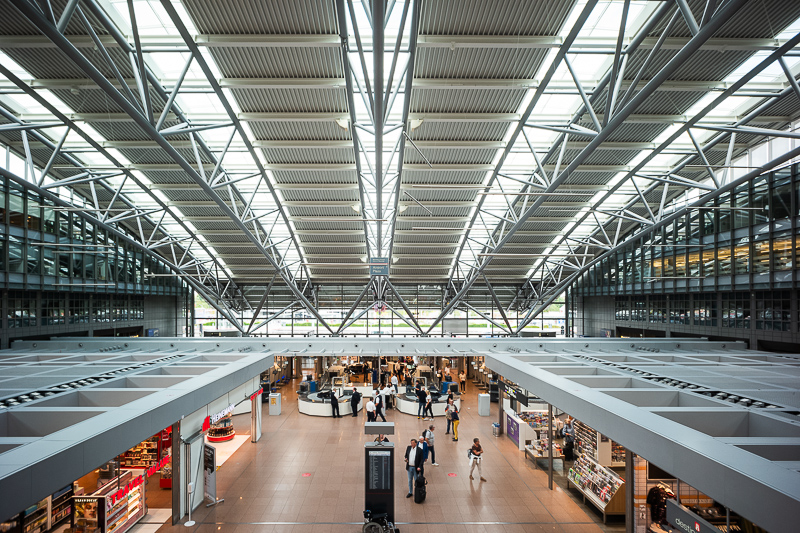
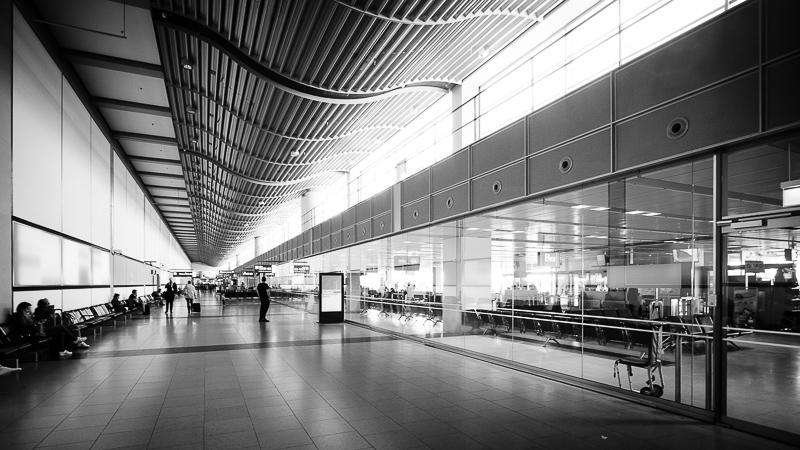
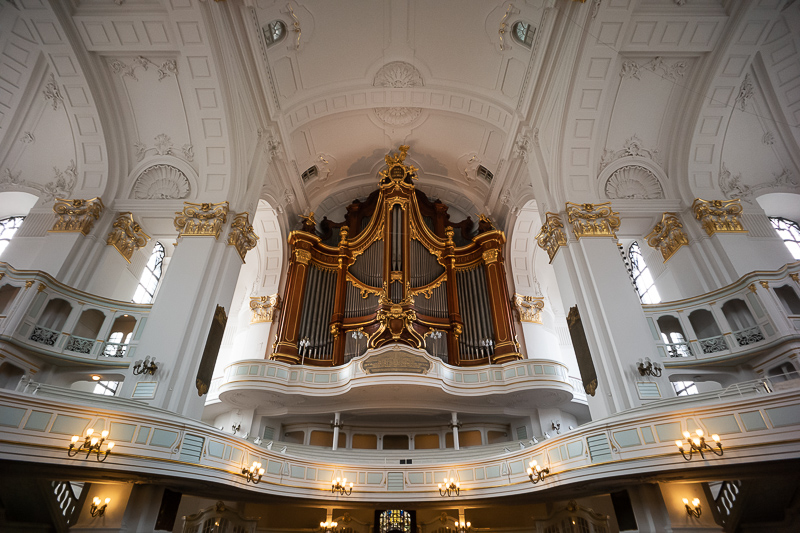
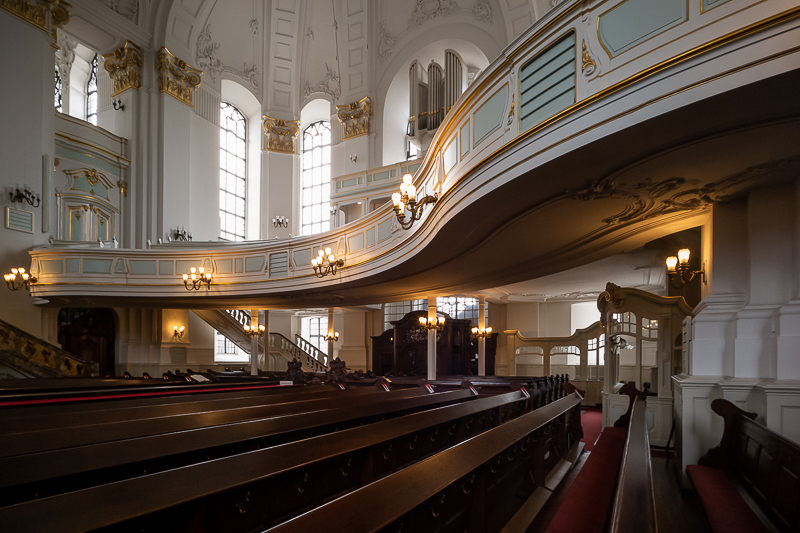
You can find most of the sample images in full resolution here.
Further Reading
- Reviews of Leica M lenses
- Analogue Adventures Landing Page
- Review: Voigtländer VM 75mm 1.5 Nokton
- Lens aberrations explained
Support Us
Did you find this article useful or just liked reading it? Treat us to a coffee!
![]()
![]()
![]() via Paypal
via Paypal
This site contains affiliate links. If you make a purchase using any of the links marked as affiliate links, I may receive a small commission at no additional cost to you. This helps support the creation of future content.
Latest posts by BastianK (see all)
- Review: Thypoch 21mm 1.4 Simera - July 12, 2025
- Review: SLRmagic 50mm 0.95 Hyperprime LM - July 5, 2025
- Full Resolution Pictures getting fixed - July 4, 2025
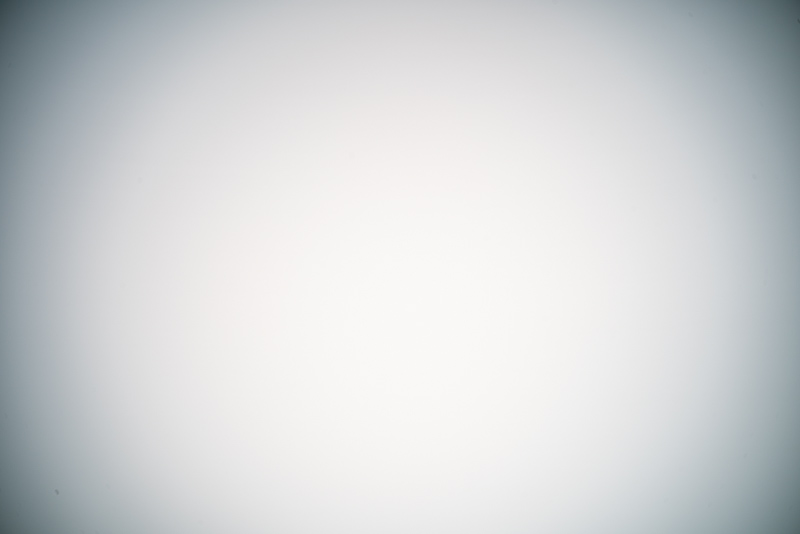
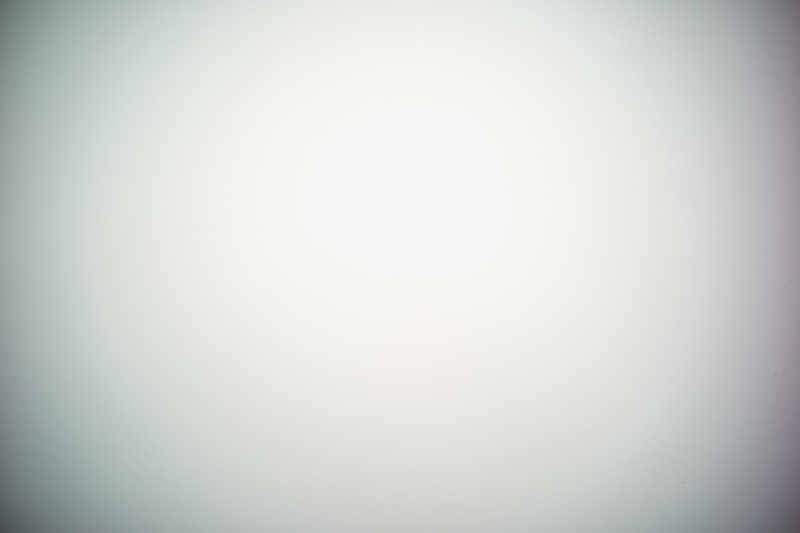
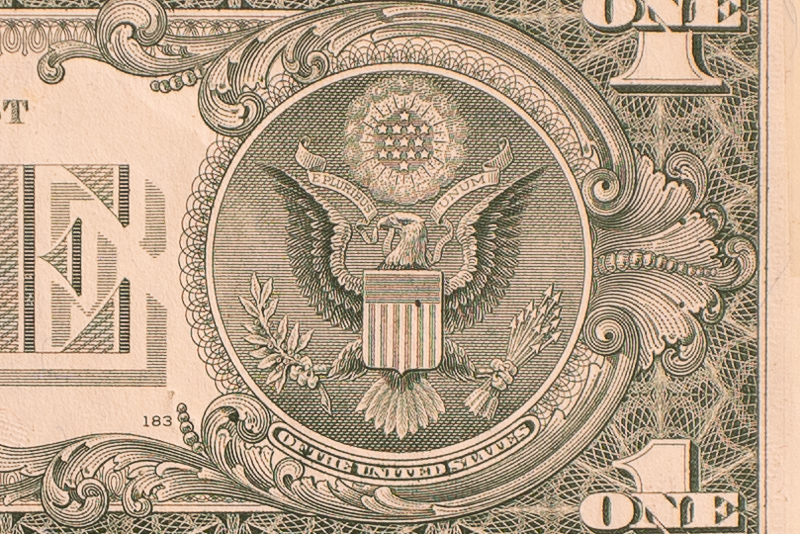
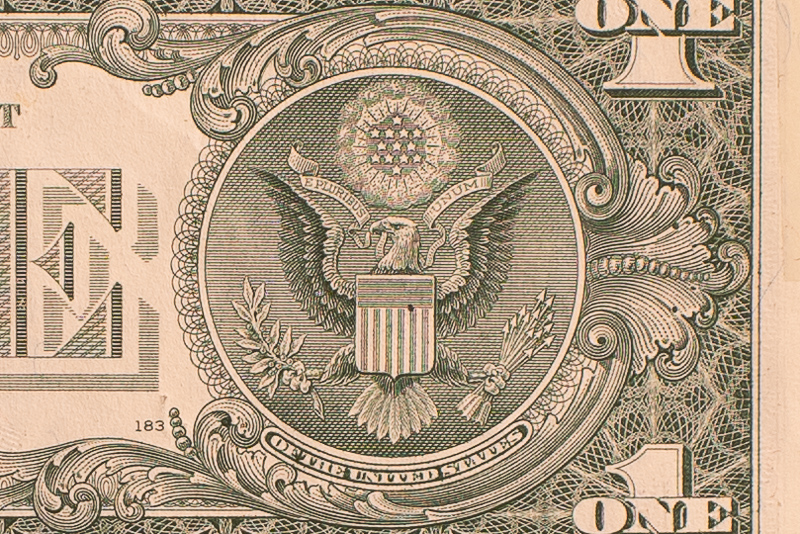
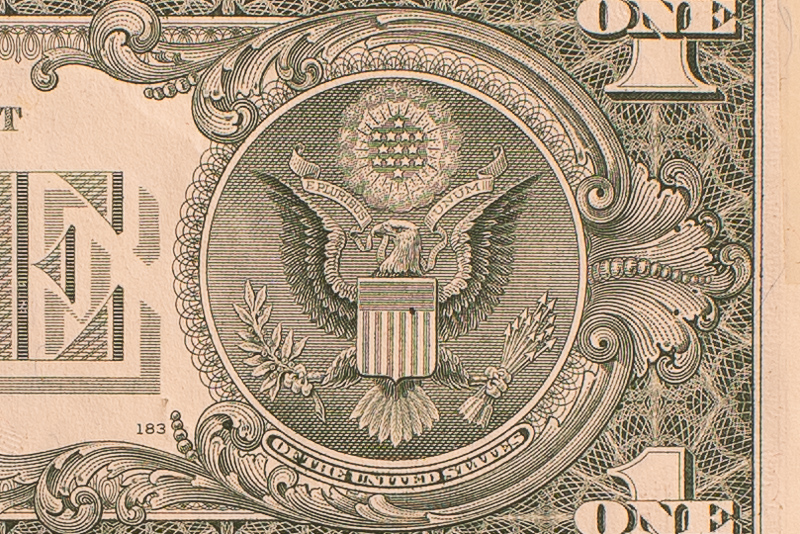
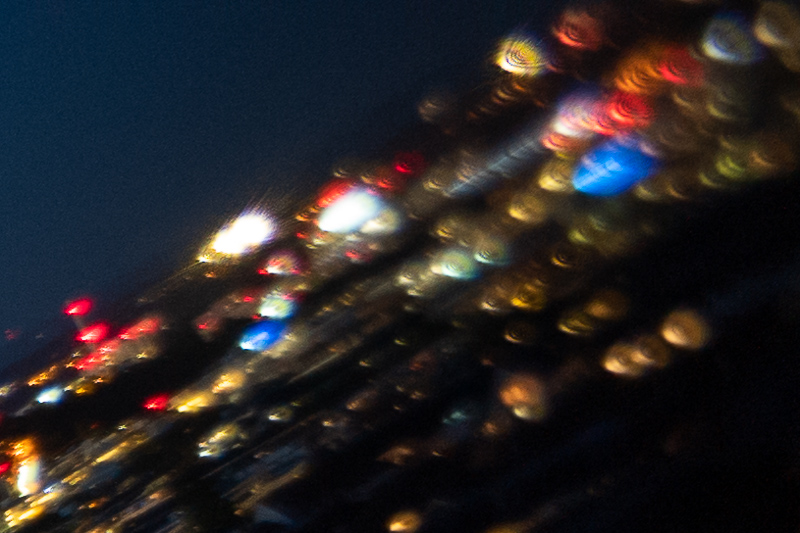
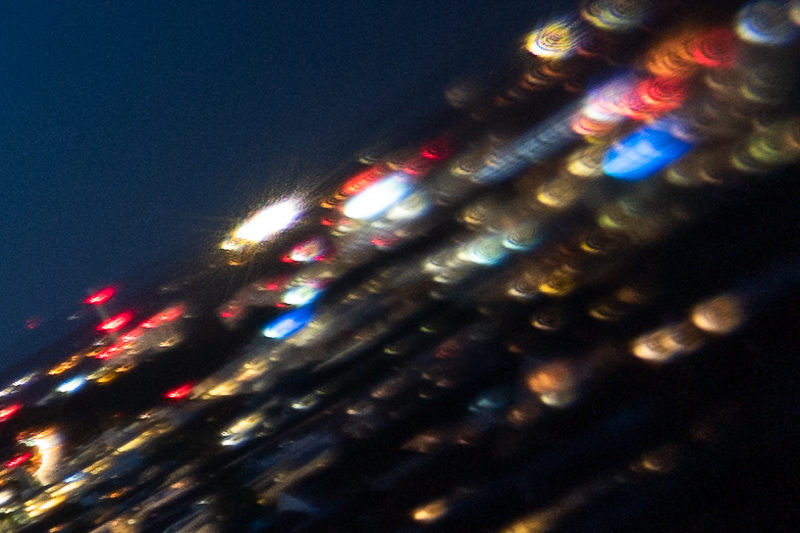
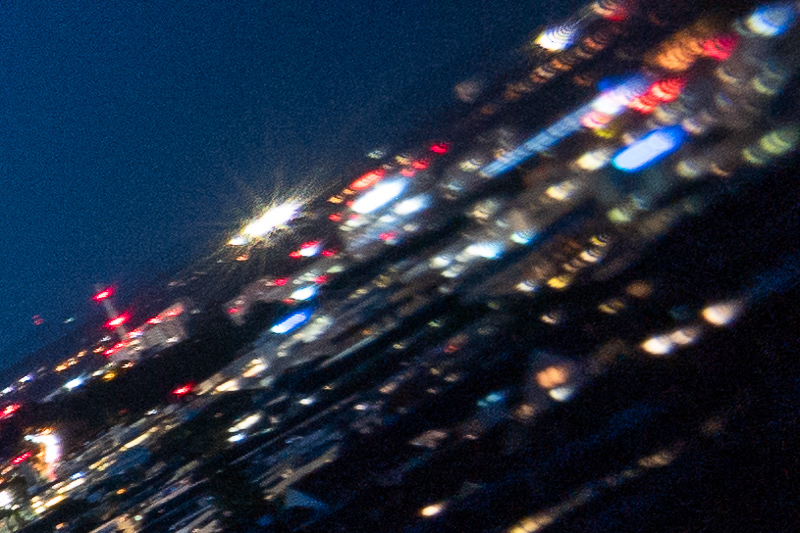
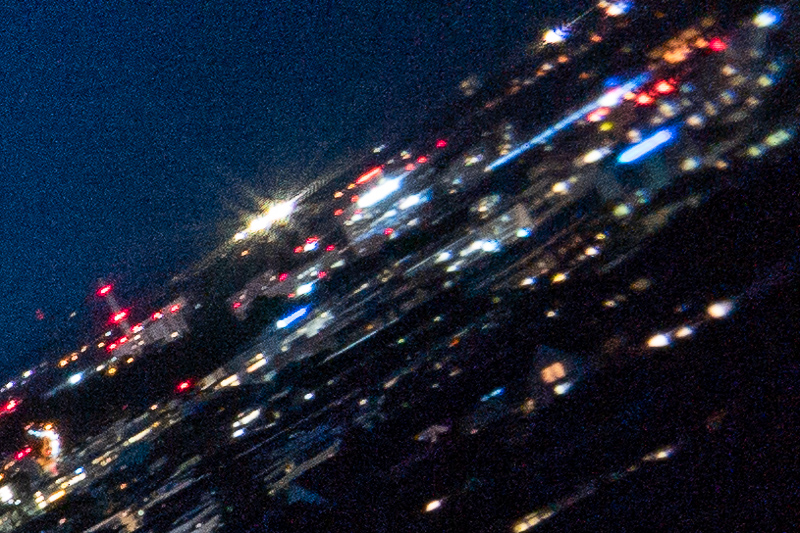
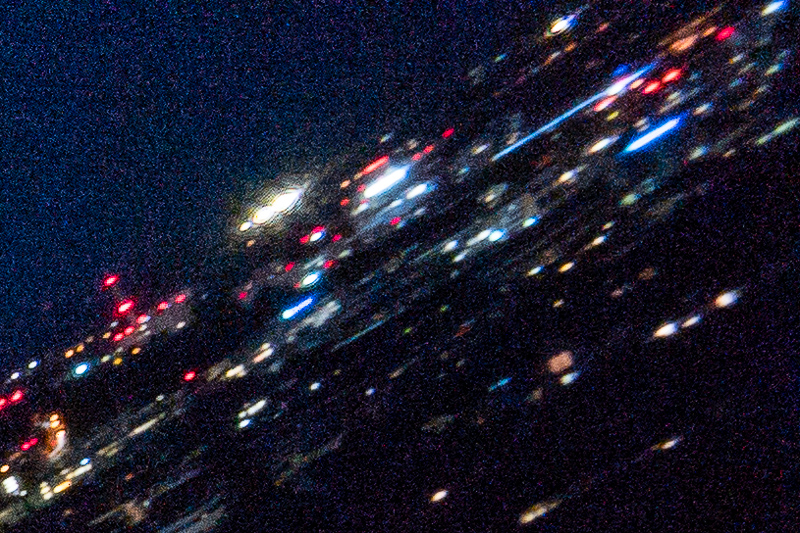
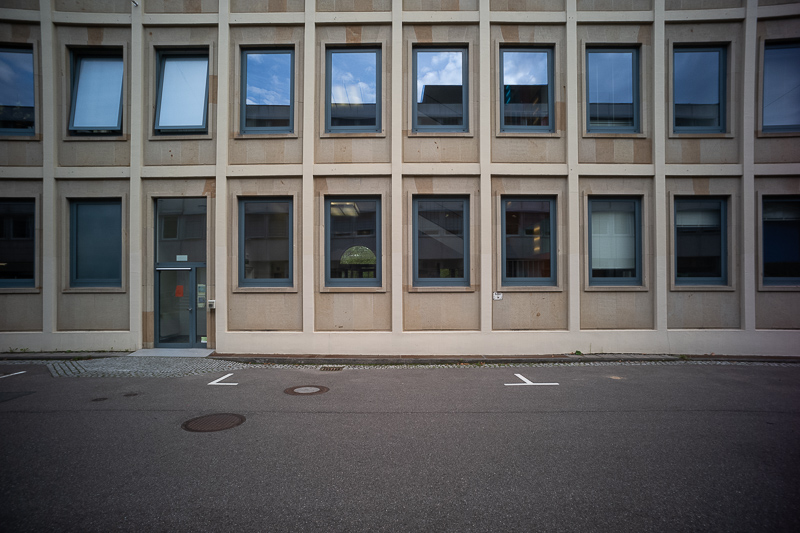
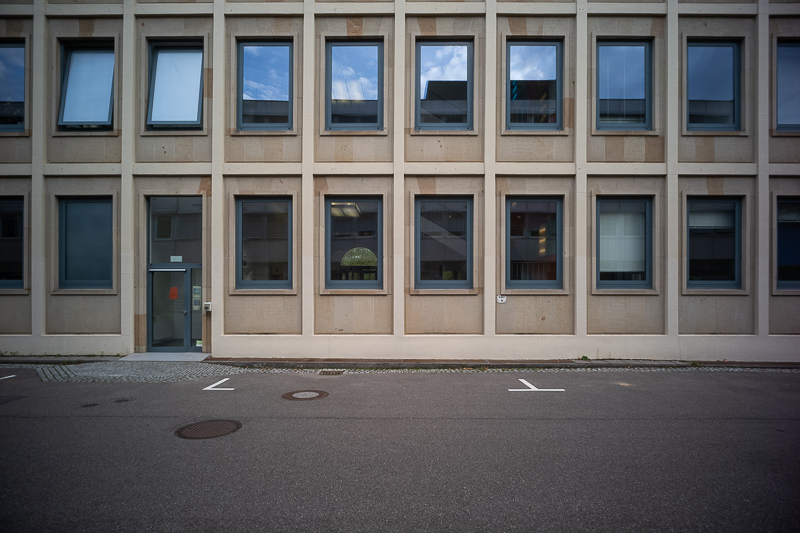
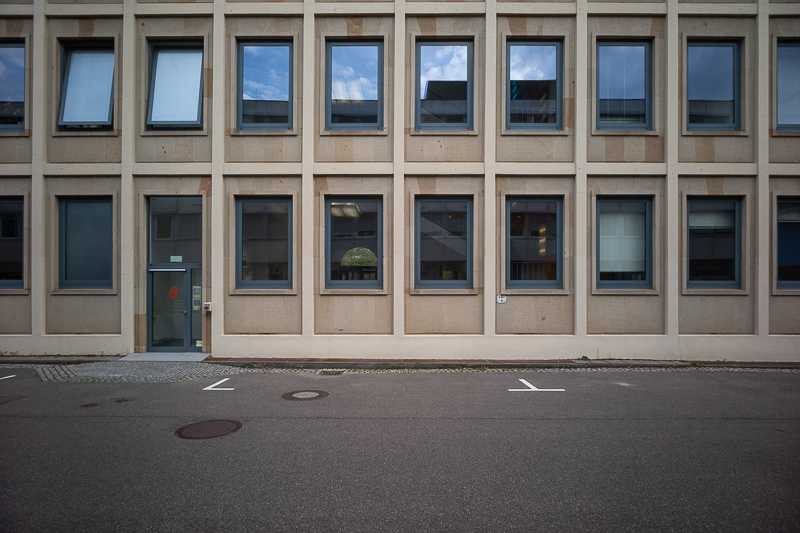
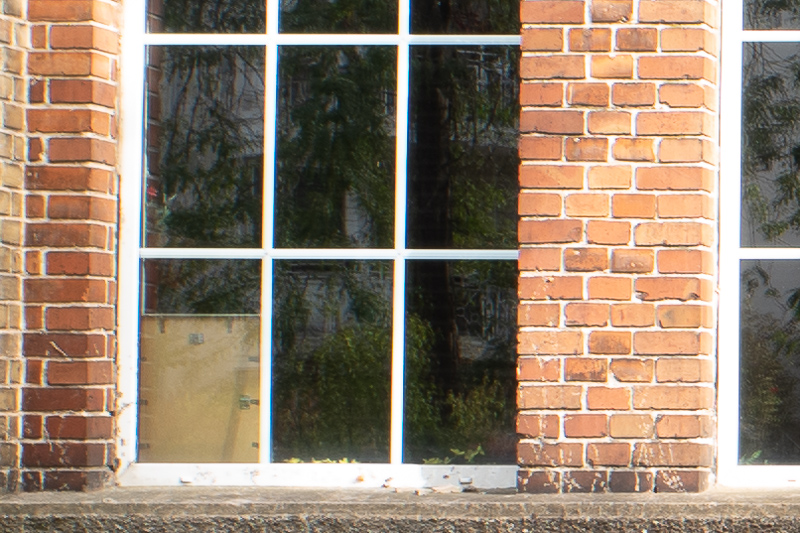
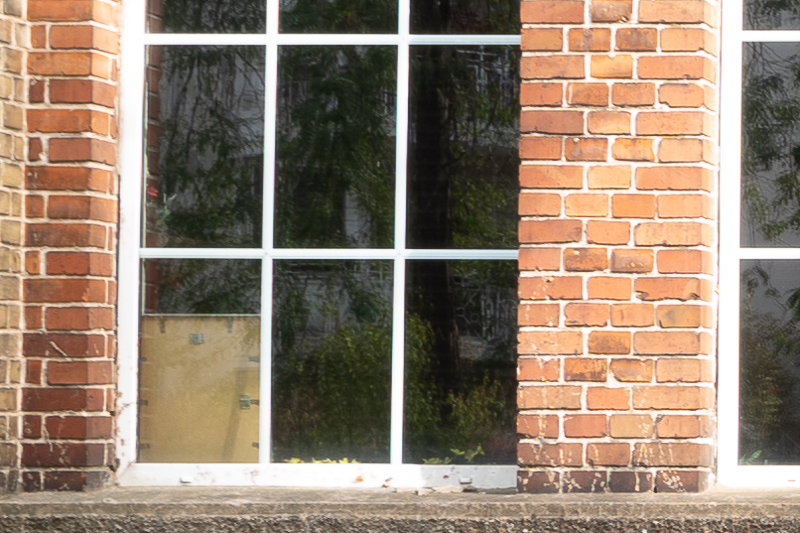
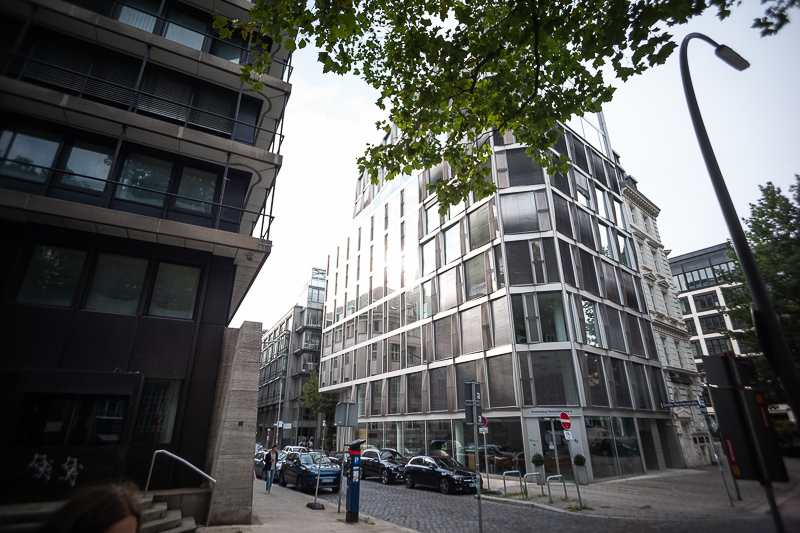
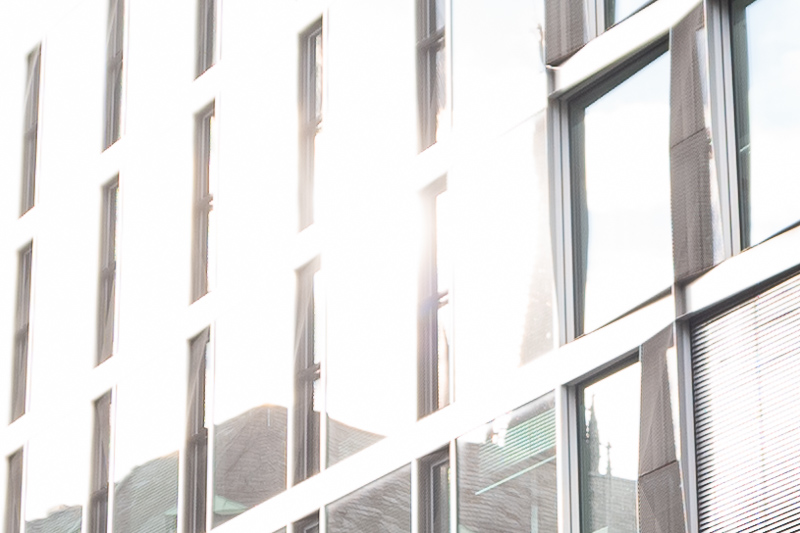
This is a just ok lens on APS-C, at best.
I disagree, I think it actually can take wonderful photos even on a full frame considering the size and focal length. Mid frame performance on FF is actually quite great so I don’t know why you think it would be “just ok” on APS-c… Just look out for the corners on FF when it’s necessary. In most pictures corners don’t matter that much.
I disagree. We obviously see things in a very different way (“In *most* pictures corners don’t matter that much…” – well, they matter to me, in my pictures) and we have different quality standards.
Which is perfectly fine, of course.
Thanks for the review Bastian. Quite an interesting lens. I like how inexpensive (relatively) it is and how small it is. I would almost buy it. The corners are probably a bit too bad for me to actually want to buy it for Sony. I actually think the mid frame looks a bit better on the Sony though.
Interestingly several MS-Optics lenses perform at bit better on Sony, at least at infinity. Personally I take this more as a coincidence though 🙂
I also have the Funleader 18mm 8.0 coming, 6 element in 5 groups design. Let’s see about that one.
This is the most uninspiring photos i’ve looked on this site, and i’m sure it’s only lens fault. Corner resolution is abysmal, overall resolution is ok at best.
Although this MS lens is obviously far away from delivering perfect image quality I‘d like to have one and „play“ with such an extraordinary and extremly small lens crafted at a high level.
Those lenses inspire to create pictures with character. For this purpose I bought two Voigtländer 15mm f4,5, the Mark 1 and the Mark III versions. Working with this manual lenses is pure fun. I could add some other imperfect but to me very attractive lenses like the Voigtländer Heliar 40mm f2,8 or the Leica C 40mm f2. Even the Zeiss 18mm f3,5 but this guy is big and heavy. 😂
Thanks Bastian for your always comparable testing standards, for your impressive pictures and for sharing your deep insights with us. I really enjoy each review at this outstanding photo blog.
“Crafted at a high level” – well brace yourself for the reality. I had a MS-converted Yashica/Zeiss 35/3.5, a 21/4.5 and a 28/2. While looking handsome and have unique characters, they are really basement projects that are rather randomly put together. Simple, single helicoid design and *very* quirky handling means it’s not even fun to just play around. The 28/2 came with a calibration issue and went back to Mr. Miyazaki via Bellamy Hunt – and came back with a fresh cut on the rear mount, which solved the problem, but the exposed metal was wildly crude for a $700 (at the time) lens.
If you’re in for an adventure, go for it. But make sure you get something with an aperture ring like the 35/1.4.
Thanks for another nice MS-Optics lens review, Bastian!
Personally I’m less inclined to go for Miyazaki-san’s widest lenses as I strongly prefer his dual-character lenses that can be used for nice close-up bokeh shots and for infinity as well for single camera & lens walkaround use. For that I prefer the 28mm to 75mm focal length range. I also have CV 15/4.5 & 21/3.5 for E-mount that cover the wide end quite well and are also reasonably compact (though considerably bigger).
Last week his Perar 35/3.5 and MS-Mode Apoqualia 50/3.5 made a rare appearance in Map Camera and Fotoborse in fine condition but they were snapped up by somebody else before I even noticed. Would have loved to get either of those at a decent price… Currently I’m thinking of adding 50/1.5 Vario Prasma to my MS-Optics set next (sometime in December).
I am actually wondering if Miyazaki passed on the company to a successor or if he hired additional workforce.
I have the feeling the production numbers have increased lately and we also saw many rereleases I personally didn’t see coming.
These 35/3.5 and 50/3.5 that appeared last week were old copies (just 1 of each) from some previous owner and didn’t have the packaging or all parts like front caps.
It seems to me that Miyazaki-san is still making some additional copies of certain lenses that were released in past 5 years in small numbers and mostly delivering those through MKDirect these days but in most physical Tokyo stores that carry MS-Optics lenses there’s been very little new stock lately. Map Camera got some new 50/1.3 Sonnetars recently but that’s about it. Fotoborse has much less stock now than they used to have a couple of months ago and GT Camera has nothing now. Xenomax 50/3.5 hasn’t been seen in any physical stores that I keep an eye on except Fotoborse and they also ran out of stock earlier. Xenomax seems to be mostly supplied by MKDirect and JCH.
Lemonsha (across their 4 stores in Tokyo) keep some stock that they’ve had for a long time but not much new (they still have some 28/2-III Urushi, 50/1.5 Vario Prasma, 73/1.5, 40/6.3 (both versions), 50/1.3 Slim, 35/1.3 II Slim, 135/2.8) spread across their stores but seems to be just few copies overall and different stores have different lenses…
I get the feeling that MKDirect are very closely associated with Miyazaki-san and working together but I don’t know if he has any additional workforce working on the actual lens production.
As I am mostly monitoring MK Direct and JCH it is very well possible I got a wrong impression!
I think MKDirect is directly associated with Miyazaki-san since on Google Maps MS-Optics company links to MKDirect and the Twitter-account (https://twitter.com/MS_OPTICS) is stating that “This is the official account of msoptics . Please purchase products from this site.” and they link to MKDirect store, and the Instagram account is similar. So I think Miyazaki-san is supplying MKDirect as first priority nowadays. I’m also thinking of getting VarioPrasma directly from there (haven’t bought from MKDirect before).
Great review! This is quite an intriguing lens. Thank you Bastian.
Hi Bastian,
thank you for that great review. I was last week in Hamburg, and I visited many spots you showed us in your pics.
The Perar is very usable after having the pics postprocessed. And I am still fascinated, that only 4 lenses are enough for that huge angle of view.
btw: japanexposures still has some MS-Optics lenses in stock, including the Xenomax (silver version).
Best regards, and ceep on testing…
Christian
Would have not been possible without you 🙂
Hi Bastian,
I use the M10r with 28 f2 and 50 apo; I am looking for something very, I mean, very thin to carry with me when I need more reach on the wider side.
So I found this lens, and the Funleader as well.
I need you to understand, which one gives you a better quality with the known limits.
Is it a waste of money to invest in them (even the FL is very cheap)?
I know the 15 by Voigtlander and the 12 as well and to be honest, I can’t say both are great and the size is quite a problem.
Thanks for your answer!
When trying the Hologon 16mm 8.0 on M10r and M11 in store I found it has more issues with color cast on the M10r than the M10. A lot more actually.
Some people claim the VM 21mm 4.0 performs better on M10r than M10 though, but I haven’t seen strong enough proof to believe that.
So I would rather avoid the Funleader 18mm 8.0, the Perar 17mm 4.5 and the smaller VM 15mm 4.5 MK I/II as well as the 12mm 5.6 MK I/II on the M10r.
My “very thin” option is the Hologon 16mm 8.0 with all the drawbacks outlined in my review.
I also still have the VM 15mm 4.5 MKII, which does need flat field correction on M10 and may work even worse on M10r.
And if you are not happy with the performance of the 15mm 4.5 MK III and 12mm 5.6 III already calculated for digital it is getting hard to find something recommendable.
The Leica 16-18-21mm 4.0 isn’t really better than the VM 15mm 4.5 and a huge lens, the ZM 15mm 2.8 is even bigger.
I currently have a review sample of the new Laowa 15mm 2.0 for M-mount. You might be happy with it at ~f/4.0 and it is smaller
and lighter than the slower ZM 15mm 2.8, but still 420g and I wouldn’t call it thin :/
WOW, it seems I have no more choices…
I tried the Laowa with the 11mm, but I found it so wide and problematic with a tilted corner.
So I am not more confident about that brand, Buying now a lens to find it tilted because of the poor QC.
I use the Batis 18 on Sony and I need the same solution on an M so I can fly with one body and two/three thin lenses.
The colour cast is not a big problem, what concerns me is the “gone” corners or tilted lenses; something I would say to myself “why don’t you use the UWA lens of your iPhone?”
The size limit gives me three choices,
21 3.5 by voigt (same price as the Perar)
21 f4 by voigt (cheaper)
your 15 mkii (hard to find…seriously HARD)
and these two 17 Perar and 18 FL.
I see how bad is the FL so my question is, is the same poor performer this Japanese gem?
I really tend to recommend you to stay away from the Perar.
The likelihood of receiving a “non perfect sample” so to say is higher than anywhere else.
If you are okay with 21mm be sure to get the 21mm 3.5, it is really good and will be a good fit to the 28mm 2.0 and 50 Apo.
The 15mm 4.5 MKII I would probably import from Japan via ebay. I still see a few listed there and it isn’t really more expensive than trying to find a used one.
Thanks for your reply.
My idea was to have a small lens just when needed, the experience with the 11 4.5 was not great also for the size, the purpose to correct vertical lines thanks to the extreme angle was wrong.
Not enough sharpness to achieve a nice result.
So if I remember correctly, the 15 by Voigtlander is the same optically between mark i and ii; the mk1 (m39) is quite easy to find online.
I had the 12mm m39 on Sony but I suppose this (15) will be more kind having the m10r and not a Sony to use.
So, inside a church, or in the streets of Florence is better:
21 3.5 on vertical stitch
15 4.5 (less sharp and slow)
or just using the 28 f2, crazy sharp already at f2 in stitching?
The 15 f2 seem a NICE solution ….
?
If you can live with the size the 15mm 2.0 is nice.
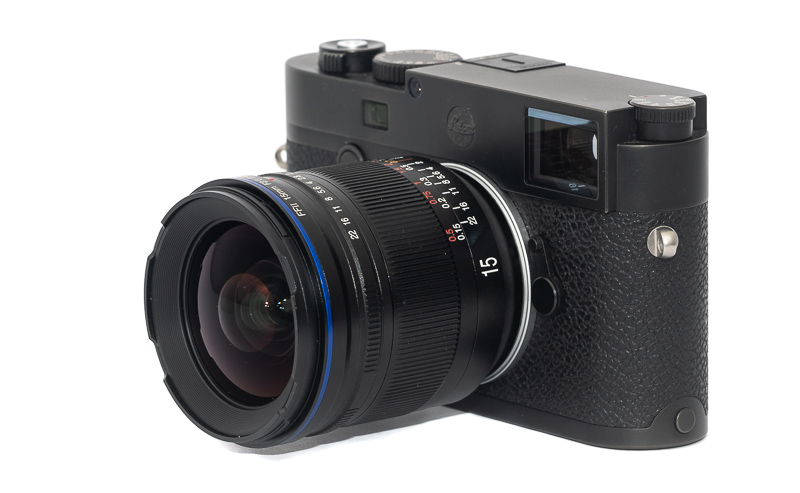
21mm 3.5 is a bit better optically than the 15mm 4.5 (MKI and MKII are same optically, yes) and needs no correction for color cast.
But then 15mm and 21mm are a significant difference.
Stitching with the 28mm, by my experience some luck (or a nodal adapter) is needed and perfectly correcting the vignetting with these manual no-exif lenses is also not that easy.